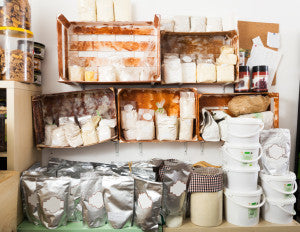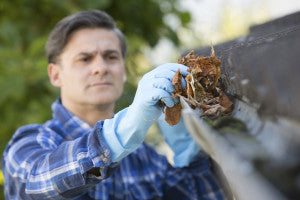By Beth Buck

Getting one's food storage together is a tall order, especially if you have a large family. Even if you only stock up on the basics like
rice,
beans, and
wheat, the total cost can run into a lot of money. But what happens when the disaster you're preparing for wipes out your food storage, too? A bucket of wheat isn't going to do you any good when it is under six feet of water. Losing your food storage in a disaster will feel like a double loss: those emergency preparedness supplies were supposed to see you through! Without your preps, how will you get through the disaster?
Sadly, there is no way to completely prevent any given disaster from happening; you can only do what you can to prepare and then hope for the best. Yet these five basic preparatory measures can go a long way towards minimizing damage and protecting your belongings, including your food storage.
1. Don't assume that you will never experience flooding. When Hurricane Harvey hit Texas, areas that had never flooded before got several feet of water. Even if your home is well outside the flood plane, everyone can experience problems with rain gutters and leaky water heaters.

2. Perform simple maintenance on your home. Clean out your rain gutters regularly and affix extenders to your down spouts to keep water away from your window wells. Several years ago rain from clogged gutters fell directly into our window well. The water seeped through the seal around the window and flooded part of the basement. Be aware of your city's arrangements for runoff water and Replace out if your city has a specific municipal plan in the event of flooding. Check periodically that your water heater is in working order. One specialist I know recommends replacing your water heater every ten years. He told me, “They're like ticking time bombs and when they go off, they go
big.”
3. Store items appropriately. Irreplaceable items should not be stored in the basement – this goes for items with sentimental value as well as food storage. Even if you place them in a plastic tub, the lid can pop off if the water gets high enough. Simple shelving can go a long way, too. If the flooding is only for two or three inches, shelves keep everything off of the floor so it's not sitting in a puddle. Use plastic containers instead of cardboard boxes.
Superpails from Emergency Essentials include a mylar layer in addition to the air-tight rubber gasket in the lid.
4. After the flood, insurance companies will often declare things a total loss, but don't let that stop you from examining your food storage thoroughly. Some of it might have survived! #10 cans may rust, but
do check the contents of any buckets. The
retort pouches used for MREs should withstand flooding. If you are worried about bacterial contamination from the floodwater, boiling the pouches before eating the contents will kill all the germs.
5. Finally, when you have lost everything, including your food storage, don't be afraid to build up your food storage supply again. In June of 1976, muddy water from the
Teton Dam swept away everything Bob had (not his real name). Bob and his family was able to stay with a friend during cleanup efforts. One day Bob expressed his frustration, saying that he would never bother with food storage again, as it had all gone to waste in the destruction. His friend replied, “It's a good thing I had mine, then, since that's what you've been living on for the last two weeks.” Bob changed his tune after that.
These steps can help minimize the damage, especially in a small-scale flood. Even if you do lose all your foods storage, don't panic. Replacing carefully acquired food storage may feel overwhelming, but don't feel like all your preparations were a total loss, even if the flood got to them. If you were unable to use your food storage this time, you may still Replace yourself wanting food storage to fall back on in the future.
 Beth Buck has been involved with emergency preparedness since her very earliest years. She enjoys hiking, martial arts, reading, and writing about food storage. Beth lives in the Intermountain West with her family.
Beth Buck has been involved with emergency preparedness since her very earliest years. She enjoys hiking, martial arts, reading, and writing about food storage. Beth lives in the Intermountain West with her family.

 Getting one's food storage together is a tall order, especially if you have a large family. Even if you only stock up on the basics like rice, beans, and wheat, the total cost can run into a lot of money. But what happens when the disaster you're preparing for wipes out your food storage, too? A bucket of wheat isn't going to do you any good when it is under six feet of water. Losing your food storage in a disaster will feel like a double loss: those emergency preparedness supplies were supposed to see you through! Without your preps, how will you get through the disaster?
Sadly, there is no way to completely prevent any given disaster from happening; you can only do what you can to prepare and then hope for the best. Yet these five basic preparatory measures can go a long way towards minimizing damage and protecting your belongings, including your food storage.
1. Don't assume that you will never experience flooding. When Hurricane Harvey hit Texas, areas that had never flooded before got several feet of water. Even if your home is well outside the flood plane, everyone can experience problems with rain gutters and leaky water heaters.
Getting one's food storage together is a tall order, especially if you have a large family. Even if you only stock up on the basics like rice, beans, and wheat, the total cost can run into a lot of money. But what happens when the disaster you're preparing for wipes out your food storage, too? A bucket of wheat isn't going to do you any good when it is under six feet of water. Losing your food storage in a disaster will feel like a double loss: those emergency preparedness supplies were supposed to see you through! Without your preps, how will you get through the disaster?
Sadly, there is no way to completely prevent any given disaster from happening; you can only do what you can to prepare and then hope for the best. Yet these five basic preparatory measures can go a long way towards minimizing damage and protecting your belongings, including your food storage.
1. Don't assume that you will never experience flooding. When Hurricane Harvey hit Texas, areas that had never flooded before got several feet of water. Even if your home is well outside the flood plane, everyone can experience problems with rain gutters and leaky water heaters.
 2. Perform simple maintenance on your home. Clean out your rain gutters regularly and affix extenders to your down spouts to keep water away from your window wells. Several years ago rain from clogged gutters fell directly into our window well. The water seeped through the seal around the window and flooded part of the basement. Be aware of your city's arrangements for runoff water and Replace out if your city has a specific municipal plan in the event of flooding. Check periodically that your water heater is in working order. One specialist I know recommends replacing your water heater every ten years. He told me, “They're like ticking time bombs and when they go off, they go big.”
3. Store items appropriately. Irreplaceable items should not be stored in the basement – this goes for items with sentimental value as well as food storage. Even if you place them in a plastic tub, the lid can pop off if the water gets high enough. Simple shelving can go a long way, too. If the flooding is only for two or three inches, shelves keep everything off of the floor so it's not sitting in a puddle. Use plastic containers instead of cardboard boxes. Superpails from Emergency Essentials include a mylar layer in addition to the air-tight rubber gasket in the lid.
4. After the flood, insurance companies will often declare things a total loss, but don't let that stop you from examining your food storage thoroughly. Some of it might have survived! #10 cans may rust, but do check the contents of any buckets. The retort pouches used for MREs should withstand flooding. If you are worried about bacterial contamination from the floodwater, boiling the pouches before eating the contents will kill all the germs.
5. Finally, when you have lost everything, including your food storage, don't be afraid to build up your food storage supply again. In June of 1976, muddy water from the Teton Dam swept away everything Bob had (not his real name). Bob and his family was able to stay with a friend during cleanup efforts. One day Bob expressed his frustration, saying that he would never bother with food storage again, as it had all gone to waste in the destruction. His friend replied, “It's a good thing I had mine, then, since that's what you've been living on for the last two weeks.” Bob changed his tune after that.
These steps can help minimize the damage, especially in a small-scale flood. Even if you do lose all your foods storage, don't panic. Replacing carefully acquired food storage may feel overwhelming, but don't feel like all your preparations were a total loss, even if the flood got to them. If you were unable to use your food storage this time, you may still Replace yourself wanting food storage to fall back on in the future.
2. Perform simple maintenance on your home. Clean out your rain gutters regularly and affix extenders to your down spouts to keep water away from your window wells. Several years ago rain from clogged gutters fell directly into our window well. The water seeped through the seal around the window and flooded part of the basement. Be aware of your city's arrangements for runoff water and Replace out if your city has a specific municipal plan in the event of flooding. Check periodically that your water heater is in working order. One specialist I know recommends replacing your water heater every ten years. He told me, “They're like ticking time bombs and when they go off, they go big.”
3. Store items appropriately. Irreplaceable items should not be stored in the basement – this goes for items with sentimental value as well as food storage. Even if you place them in a plastic tub, the lid can pop off if the water gets high enough. Simple shelving can go a long way, too. If the flooding is only for two or three inches, shelves keep everything off of the floor so it's not sitting in a puddle. Use plastic containers instead of cardboard boxes. Superpails from Emergency Essentials include a mylar layer in addition to the air-tight rubber gasket in the lid.
4. After the flood, insurance companies will often declare things a total loss, but don't let that stop you from examining your food storage thoroughly. Some of it might have survived! #10 cans may rust, but do check the contents of any buckets. The retort pouches used for MREs should withstand flooding. If you are worried about bacterial contamination from the floodwater, boiling the pouches before eating the contents will kill all the germs.
5. Finally, when you have lost everything, including your food storage, don't be afraid to build up your food storage supply again. In June of 1976, muddy water from the Teton Dam swept away everything Bob had (not his real name). Bob and his family was able to stay with a friend during cleanup efforts. One day Bob expressed his frustration, saying that he would never bother with food storage again, as it had all gone to waste in the destruction. His friend replied, “It's a good thing I had mine, then, since that's what you've been living on for the last two weeks.” Bob changed his tune after that.
These steps can help minimize the damage, especially in a small-scale flood. Even if you do lose all your foods storage, don't panic. Replacing carefully acquired food storage may feel overwhelming, but don't feel like all your preparations were a total loss, even if the flood got to them. If you were unable to use your food storage this time, you may still Replace yourself wanting food storage to fall back on in the future.
 Beth Buck has been involved with emergency preparedness since her very earliest years. She enjoys hiking, martial arts, reading, and writing about food storage. Beth lives in the Intermountain West with her family.
Beth Buck has been involved with emergency preparedness since her very earliest years. She enjoys hiking, martial arts, reading, and writing about food storage. Beth lives in the Intermountain West with her family.


